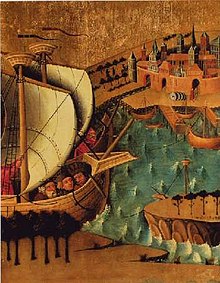Master of the Rostock Three Kings Altar
Master of the Rostock Dreikönigsaltar is the emergency name of a north German painter who worked in the first half of the 15th century.
It was named after its main work, the former high altar of the church of the Rostock St. John 's Monastery of the Dominicans . The former high altar of the Church of St. Peter and Paul in Teterow , a double-winged retable with a painted cycle of the Passion in 16 individual depictions , is also attributed to this master .
The Rostock three king altar
The winged altar from the Dominican Church in Rostock, dated around 1425, is a convertible altar with two pairs of wings. It was donated by the "Brotherhood of the Three Magi" ( fraternitas trium regum ) existing at the Dominican monastery . It is known for having the oldest cityscape of Rostock on it. It has been preserved in fragments. Several parts - the inner pair of wings and numerous carved figures - can be seen today in the cultural history museum in the monastery of the Holy Cross in Rostock, two panels from the right outer wing are in the Märkisches Museum in Berlin.
The crucifixion of Jesus was depicted in the central shrine . On the outer sides of the inner pair of wings there are eight painted scenes depicting the legend of the Magi: the discovery of the star of Bethlehem , the meeting of the kings with Herod against the backdrop of the city of Jerusalem , the proclamation of the birthplace of Bethlehem , the adoration of the baby Jesus and the offering of gifts, the nighttime appearance of the angel, who warns of a return to Herod, the journey home of the kings by ship (in front of a view of the city of Rostock), the baptism of kings by the Apostle Thomas and the funeral mass Melchior for Kaspar and Balthasar . The outer wings probably had scenes from the lives of John the Baptist and John the Evangelist . The center shrine and the inner sides of the inner pair of wings also showed 16 wooden sculptures of standing saints, each under a canopy , including the twelve apostles , the holy founder of the order Dominic and the Dominican saint Thomas Aquinas .
On the predella were carved representations of Moses and the prophets and the wise and foolish virgins .
literature
- Friedrich Adolf Martens: The three king altar of the former Johanniskirche in Rostock. In: Contributions to the history of the city of Rostock , Vol. 18 (1933), pp. 79-102.
Web links
Individual evidence
- ^ Verena Friedrich / Martin Kuske: Teterow. (= Peda art guide No. 81). Peda, Passau 1993, ISBN 3-927296-88-0 , p. 14.
- ↑ Steffen Stuth: Rostock, Monastery S. Johannes the Baptist, S. Johannes Evangelist. 7.5. Art-historical classification. In: Wolfgang Huschner , Ernst Münch, Cornelia Neustadt, Wolfgang Eric Wagner: Mecklenburg monastery book. Handbook of the monasteries, monasteries, coming and priories (10th / 11th - 16th centuries). Volume II., Rostock 2016, ISBN 978-3-356-01514-0 , pp. 847-871, here pp. 864ff.
| personal data | |
|---|---|
| SURNAME | Master of the Rostock Three Kings Altar |
| BRIEF DESCRIPTION | Low German painter |
| DATE OF BIRTH | 14th century or 15th century |
| DATE OF DEATH | 15th century |
